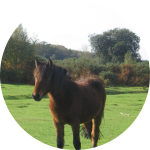| Home |
Welcome to the Horse Stall |
|
Horse Stall contains all types of information for Horse Lovers.
There are a number of products branded horse gifts and products.
Horse Articles :: Horse Breed Glossary - N
|
Horse Breed Glossary - N |
|
NEW KIRGIZ HORSE When farms in Russia crossed local horses of the Thoroughbred and the Don, they ended up with the breed called New Kirgiz. This breed is adapted to highland conditions, and are most often used for meat, milk production and stock work. New Kirgiz has short legs and a strong constition. They look much like Don horses. The New Kirgiz breed stallions are about 156 cm in height at the withers, and a body length of 158 cm. Mares of the breed are slightly smaller in all measurements. Their heads are medium sized and have low necks, their backs are straight and level with very muscled croups. There are three types within the breed, New Kirgiz. There is a saddle type, a thick and massive type and a standard type. There are over 56,000 New Kirgiz. NEWFOUNDLAND PONY A proud aspect of the Newfoundland culture and the history of the area, the Newfoundland Pony was brought from the British Isles by early settlers. The characteristics of the pony includes horses that are 11 to 14 hands in height, have thick mane and tale that is most often a brownish color. Newfoundland ponies often change color between the seasons. They weight between 400 and 800 pounds. They have characteristically good temperaments, and can survive on small amounts of grass and foods. They are able to survive harsh winters because of a thick, winter coat that grows for the coldest months. Newfoundland ponies are hardworking. They help transport people by back, or by cart and wagon- mostly before the car was invented. They hauled firewood and timber. When machinary took over most of the jobs the ponies were doing, the number of Newfoundland ponies were drastically reduced. Many thousands of ponies were sold to meat processing plants in Quebec. Numbers of Newfoundland Ponies are currently increasing thanks to restrictions and governmental intervention to help the breed survive. NOMA HORSE A light draft and riding horse that originated in Noma County, Japan, the Noma breed is th smallest pony native to Japan that stands at about 10 hands tall. The breed was developed in the 17th century and descended from Mongolian stock. The status of the Noma breed is extremely rare, with only about 27 purebreds in existence. They are preserved as part of local heritage. NOOITGEDACHT PONY Found in South Africa, in the eastern Transvaal region, the Nooitgedacht Pony is used for draft and riding purposes. The breed originated in the 1950's from a mixture of Basuto Pony, Arab and Boer blood. The breed is very rare. NORDLAND HORSE The origination of the Nordland pony is mostly based on speculation. Researchers believe the horse came into Norway during very early times, and that the horses were forced north. After World War II, the breed was almost extinct. The breed became scattered because of environmental conditions in Norway, and each area gave the pony a different name. The ponies in different areas developed characteristics according to their environments as well. There is some belief that the Nordland pony is a combination of two different types of horse within the same race- the Lyngen in Troms and another type from within Norland. The pony's conformation is good with all colors accepted except for dun and pied. Most dominant however are chesnut horses. Nordland ponies are easy to train, energetic and of good temper- they are also very willing to work. They are mostly free from health problems and live to about the age of 30. Most people use Nordland ponies for riding, as a pack horse or for driving. They are great jumpers and show ponies. Their current status is rare. NORIC HORSE The Noric, or the Noriker, has lived and bred for over 2000 years in Austria. The Noric breed has undergone numerous changes in characteristics over the years of their existence, due to selective breeding and natural selection. As the landscape and climate changed, the horses became more of a versatile, cold blooded breed of heavy weight. These horses could be used as carriage horses, riding horses, and knights during the Middle Ages. Noric horses differ from other draft or heavy breeds in a variety of ways. Noric horses have personality, nerves, and are qualified work horses. Most have endurance and a tame character alongside a toughness that has been necessary for the rough environment of their native land. Norics are not as heavy as Belgian or Percheron horses, and so are best suited for working in the Alpine ofrest. They are economical horses. Now, Norics are becoming sport horses, and are used as riding and driving horses. Because of increases in ecological awareness, Noric horses are often used instead of machinary to work in alpine regions. They carry tourists in carriages. The breed is not as fertile as most people hope. The Noric stallions tend to be about 155 cm in height at the withers, and are found in black, chestnut and bay colors, as well as a small percentage of leopards and roans. About the Author |
Top Horses |
|
| Top Horse Movies | |
Horse Resources |
|
Horse Health |
|
Horse Breeds |
|
More Horses |
|


| Copyright 2005-2021 DR Management All rights reserved |
Dog Gifts | Wildlife Gifts | Handmade Horse Gifts |
